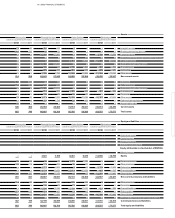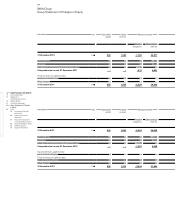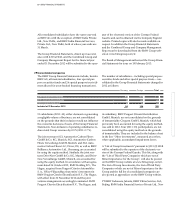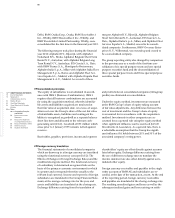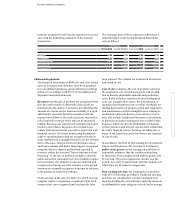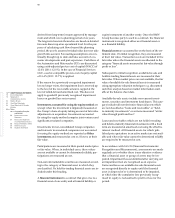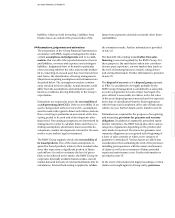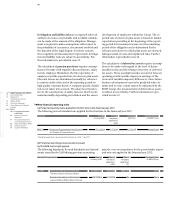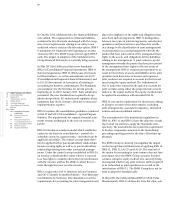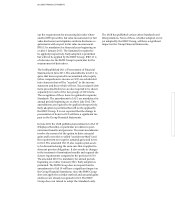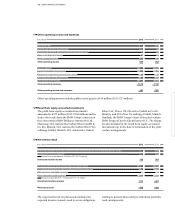BMW 2012 Annual Report Download - page 91
Download and view the complete annual report
Please find page 91 of the 2012 BMW annual report below. You can navigate through the pages in the report by either clicking on the pages listed below, or by using the keyword search tool below to find specific information within the annual report.
91 GROUP FINANCIAL STATEMENTS
For machinery used in multiple-shift operations, depre-
ciation rates are increased to account for the additional
utilisation.
The cost of internally constructed plant and equipment
comprises all costs which are directly attributable to the
manufacturing process and an appropriate proportion
of production-related overheads. This includes produc-
tion-related depreciation and an appropriate proportion
of administrative and social costs.
As a general rule, borrowing costs are not included in
acquisition or manufacturing cost. Borrowing costs that
are directly attributable to the acquisition, construction
or production of a qualifying asset are recognised as a
part of the cost of that asset in accordance with IAS 23
(Borrowing Costs).
Non-current assets also include assets relating to leases.
The BMW Group uses property, plant and equipment
as lessee on the one hand and leases out vehicles
pro-
duced by the Group and other brands as lessor on the
other. IAS 17 (Leases) contains rules for determining,
on the basis of risks and rewards, the economic owner
of the assets. In the case of finance leases, the assets
are attributed to the lessee and in the case of operating
leases the assets are attributed to the lessor.
In accordance with IAS 17, assets leased under finance
leases are measured at their fair value at the incep-
tion
of the lease or at the present value of the lease pay-
ments, if lower. The assets are depreciated using the
straight-line method over their estimated useful lives
or over the lease period, if shorter. The obligations for
future lease instalments are recognised as financial
liabilities.
Where Group products are recognised by BMW Group
entities as leased products under operating leases,
they are measured at manufacturing cost. All other
leased products are measured at acquisition cost. All
leased products are depreciated over the period of the
lease using the straight-line method down to their
expected residual value. Changes in residual value ex-
pectations are recognised – in situations where the
recoverable amount of the lease exceeds the carrying
amount of the asset – by adjusting scheduled depre-
ciation prospectively over the remaining term of the
lease contract. If the recoverable amount is lower than
the expected residual value, an impairment loss is
recognised for the shortfall. A test is carried out at
each balance sheet date to determine whether an im-
pairment loss recognised in prior years no longer
exists or has decreased. In these cases, the carrying
amount of the asset is increased to the recoverable
amount. The higher carrying amount resulting from
the reversal may not, however, exceed the rolled-
forward amortised cost of the asset.
If there is any evidence of impairment of non-financial
assets (except inventories and deferred taxes), or if an
annual impairment test is required to be carried out –
i.e. for intangible assets not yet available for use, in-
tangible assets with an indefinite useful life and good-
will acquired as part of a business combination – an
impairment test pursuant to IAS 36 (Impairment of
Assets) is performed. Each individual asset is tested
separately unless the asset generates cash flows that are
largely independent of the cash flows from other assets
or groups of assets (cash-generating units / CGUs). For
the purposes of the impairment test, the asset’s carry-
ing amount is compared with its recoverable amount,
the latter defined as the higher of the asset’s fair value
less costs to sell and its value in use. An impairment
loss is recognised when the recoverable amount is lower
than the asset’s carrying amount. Fair value less costs
to sell corresponds to the amount obtainable from the
sale of an asset or groups of assets, less the costs of
disposal. The value in use corresponds to the present
value of future cash flows expected to be derived from
an asset or groups of assets.
The first step of the impairment test is to determine
the value in use of an asset. If the calculated value in use
is lower than the carrying amount of the asset, then its
fair value less costs to sell are also determined. If the
latter is also lower than the carrying amount of the asset,
then an impairment loss is recorded, reducing the car-
rying amount to the higher of the asset’s value in use
or fair value less costs to sell. The value in use is deter-
mined on the basis of a present value computation.
Cash flows used for the purposes of this calculation are


